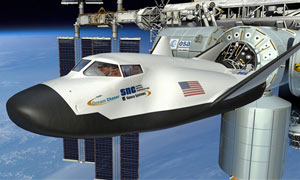NASA's Marshall Center Completes Wind Tunnel Testing for Sierra Nevada's Dream Chaser Space System
 NASA's Marshall Space Flight Center in Huntsville, Ala., successfully completed wind tunnel testing for Sierra Nevada Corp. (SNC) Space Systems of Louisville, Colo. The test will provide aerodynamic data that will aid in the design of the new Dream Chaser(r) Space System.
NASA's Marshall Space Flight Center in Huntsville, Ala., successfully completed wind tunnel testing for Sierra Nevada Corp. (SNC) Space Systems of Louisville, Colo. The test will provide aerodynamic data that will aid in the design of the new Dream Chaser(r) Space System. During tests at Marshall's wind tunnel facility, a scale model of SNC's Dream Chaser orbital crew vehicle was mounted on a scale model of the United Launch Alliance's Atlas V launch vehicle. Over 400 data runs were performed at subsonic, transonic and supersonic speeds to study the effects of how air moves past the model. Nine full-stack configurations were tested over a Mach range of .4, or 304 miles per hour at sea level, to Mach 5, or 3,800 miles per hour at sea level, at various launch vehicle roll angles.
The data generated from this test series, coupled with data from computational fluid dynamics studies, will define the aerodynamic characteristics of the Dream Chaser - Atlas V launch stack during the ascent phase of flight. Obtaining this data will enable higher-fidelity loads analysis, better definition of launch vehicle performance, and will aid in further refining Dream Chaser's trajectory design for orbital vehicle launches.
"We're glad Marshall could support SNC in completing these wind tunnel tests quickly and affordably and early in the design phase," said Teresa Vanhooser, manager of the Flight Programs and Partnerships Office at Marshall. "Our trisonic wind tunnel and engineering staff helps partners understand the aerodynamic integrity and stability of spacecraft and launch vehicles, like the Dream Chaser, over a variety of wind speeds and phases of flight."
Mark Sirangelo, corporate vice president and head of SNC's Space Systems, said: "The Dream Chaser Program is grateful for the opportunity to leverage the experience, expertise, and resources of Marshall, made possible by the unique government-commercial partnership created through NASA's Commercial Crew Development Program. Sierra Nevada Corporation looks forward to expanding our successful relationship with Marshall, as well as creating new business opportunities in the Huntsville area."
Marshall's Aerodynamic Research Facility's 14-inch trisonic wind tunnel is an intermittent, blow-down tunnel that operates from high-pressure storage to either vacuum or atmospheric exhaust. The facility is capable of conducting tests in the subsonic, transonic and supersonic mach ranges using its two interchangeable test sections. Subsonic Mach numbers are below Mach 1, the speed of sound, or 760 miles per hour at sea level, while transonic speeds approach and are slightly above Mach 1. The facility can achieve a maximum supersonic Mach number of 5, or five times the speed of sound.
SNC is currently one of the NASA Commercial Crew Development (CCDev) partners awarded funding under a Space Act Agreement to mature their Dream Chaser orbital crew transportation system. NASA's CCDev effort is being led by NASA's Kennedy Space Center and supported by NASA technical experts across the agency, including the Marshall Center for a variety of technical areas.
The effort to define the aerodynamic characteristics of the Dream Chaser Space System is being conducted under a reimbursable Space Act Agreement funded by SNC and executed with the support of aerodynamicists and wind tunnel experts from the Marshall Center and United Launch Alliance.
Last modified onSaturday, 06 May 2017 10:07
Latest from Admin TOA
- Fat Sal’s Italian Specialties Welcomes Customers in Bayville, NJ with a Renewed Concept
- FFD Wood LLC Delivers Custom Woodwork Solutions from Long Island
- A Tax Expert in the U.S. Tax World: An Interview with Samet Oynamıs
- Announcing the 2025 Edition of the 100 Most Influential Turkish Americans
- CEO Club New York Networking Night Stands Out with the Lamborghini Experience









